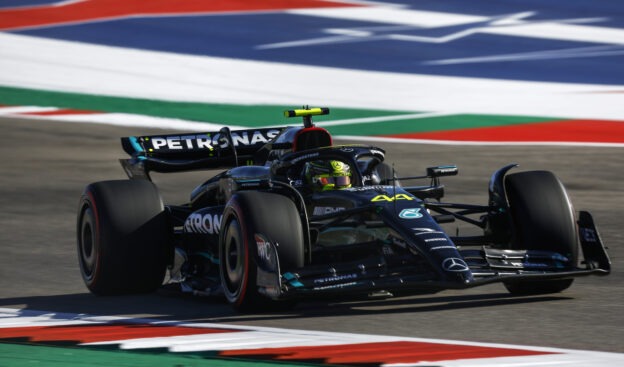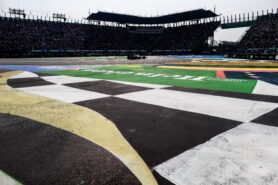Uninspected Planks and Grey Areas: The Controversy Behind F1's Disqualifications

Oct.25 - Lewis Hamilton's US GP disqualification has tongues wagging about whether changes in car legality policing needs to be improved in Formula 1.
"Ride height is so crucial for these ground effect cars that you can't really afford any gaps in control," Auto Motor und Sport's Michael Schmidt said.
It was almost four hours after the chequered flag in Austin that stewards disqualified Mercedes' Hamilton - who had finished second behind Max Verstappen - as well as Ferrari driver Charles Leclerc from the standings.
Their cars had fallen foul of Article 3.5.9e of the technical regulations, which gives teams just 1mm of allowable wear to the floor 'plank'.
But in Austin, only the top three - Verstappen's Red Bull, Hamilton's Mercedes, Lando Norris' McLaren - had their planks inspected by the post-race scrutineers, in addition to Leclerc.
Leclerc's teammate Carlos Sainz benefitted by being promoted to the podium - but his Ferrari wasn't even checked.
Also possible is that the plank wear on the offending Mercedes and Ferrari cars was not due to a true team mistake, but because of the extremely bumpy track.
"I like some of some of the bumps because it adds character to a circuit," Hamilton said. "But there's way too many."
Schmidt explained that the FIA only checks a few planks per race - and sometimes not at all at other grands prix - "due to time constraints".
"So there could have been a lot of black sheep this season," the German journalist added.
"It would be better to think about less complex control measures so the cars are more easily checked, or have other regulations that prevent teams from setting up their cars so low."
An editorial in the French magazine L'Equipe agrees: "By choosing to check certain cars and not others, it creates doubt about the legality of the other cars.
"But it's a process the FIA refuses to modify, due to lack of time and space to scrutinise all 20 single seaters. Which will always leave a grey area with results like this."
It also puts an even brighter spotlight on the controversial 'sprint' weekend format, giving teams only a single hour of practice to choose a ride height for the rest of the weekend.
"In the end, none of that matters," insists Mercedes' Toto Wolff. "Others got it right where we got it wrong."
Ferrari sporting director Diego Ioverno agrees: "We could have raised the car even more, but we would have lost performance. The compromise we opted for in the end was wrong."
Timo Glock, a former F1 driver turned pundit, told Sky Deutschland: "This is what can happen when you push the limits."
But Alexey Popov, a Russian F1 commentator, sides with those who think the current FIA system isn't fair.
"Sainz and (George) Russell most likely had the same setup as their teammates. They simply were not checked. Many others could have been in violation too," he said.
✅ Check out more posts with related topics:













I think the checking random cars is the best way, no even better dont check any cars, theres enough planks in f1 anyway
"Which will always leave a grey area with results like this."
No gray area, VER & NOR were in compliance, the other two were not. Fair or not, the rule is certainly clear.
Many racing series have post race random checks. Its a great way to enforce the rules without having to check every car. Can you imagine all the hammy fans if they hadn't checked Max's car and found it to be legal. OMG! That's all we'd be hearing about.
The planks were introduced in 1994 to prevent teams from not only running an illegal ride height but setting up the suspension such that under load the ride height becomes illegal. Even a very small decrease in ride height adds a tremendous amount of performance. I think that they have always checked the podium finishers cars in scrutineering and there is a history of cars being disqualified for excessive plank wear which means an illegal aero advantage, most notably Michael Schumacher in 1994. It is incumbent on the teams to set the suspension and ride height such that the plank will not wear beyond the allowable limit regardless of how bumpy the track is, otherwise they are gaining an illegal aero advantage and should by rule be disqualified.
Kenneth, your analysis is correct. But why single out SCH from nearly 30 yrs ago? There have been, I dare say tens, maybe hundreds of infractions since then. A bit of bias? BTW, as you are aware, the teams do the suspension setup, not the drivers.
Yes, you hit a soft spot. :):)
Michael Schumacher was just the most prominently notable disqualification as it nullified a win for him.
I did say the teams set up the car. While the driver does have input as to set-up performance the specifics such as ride height and suspension compliance are determined by the team engineers. However, as has always been if the car is disqualified so is the driver.
Loosen up, Kenny. We're not trying a case in the supreme court, or whatever the superior court is wherever you live. lol
My information is accurate , Lucy's car failed by 0.8mm on the plank test, end of.........That is unacceptable and they should be banned for this race Damn cheats.......lol
Meanwhile no more drugs for me lol , Exactly how much did the cars fail the test by, ive just listened to Loretta saying 0.1mm doesn't make a difference, but that isnt saying how much they failed by
I was thinking disqualification from the championship and $1m fine, you are too kind. lol
Sounds very dodgy. If a car fails check the sister car at the very least.
the cars were checked because the fia could see on some sensors they have on the car that all wasn't right, so they checked LH and CL and they failed then to check to see whether the testing equipment was correct they tested two other cars and they passed to , its not rocket science
✅ Checkout the latest 50 F1 Fans comments.